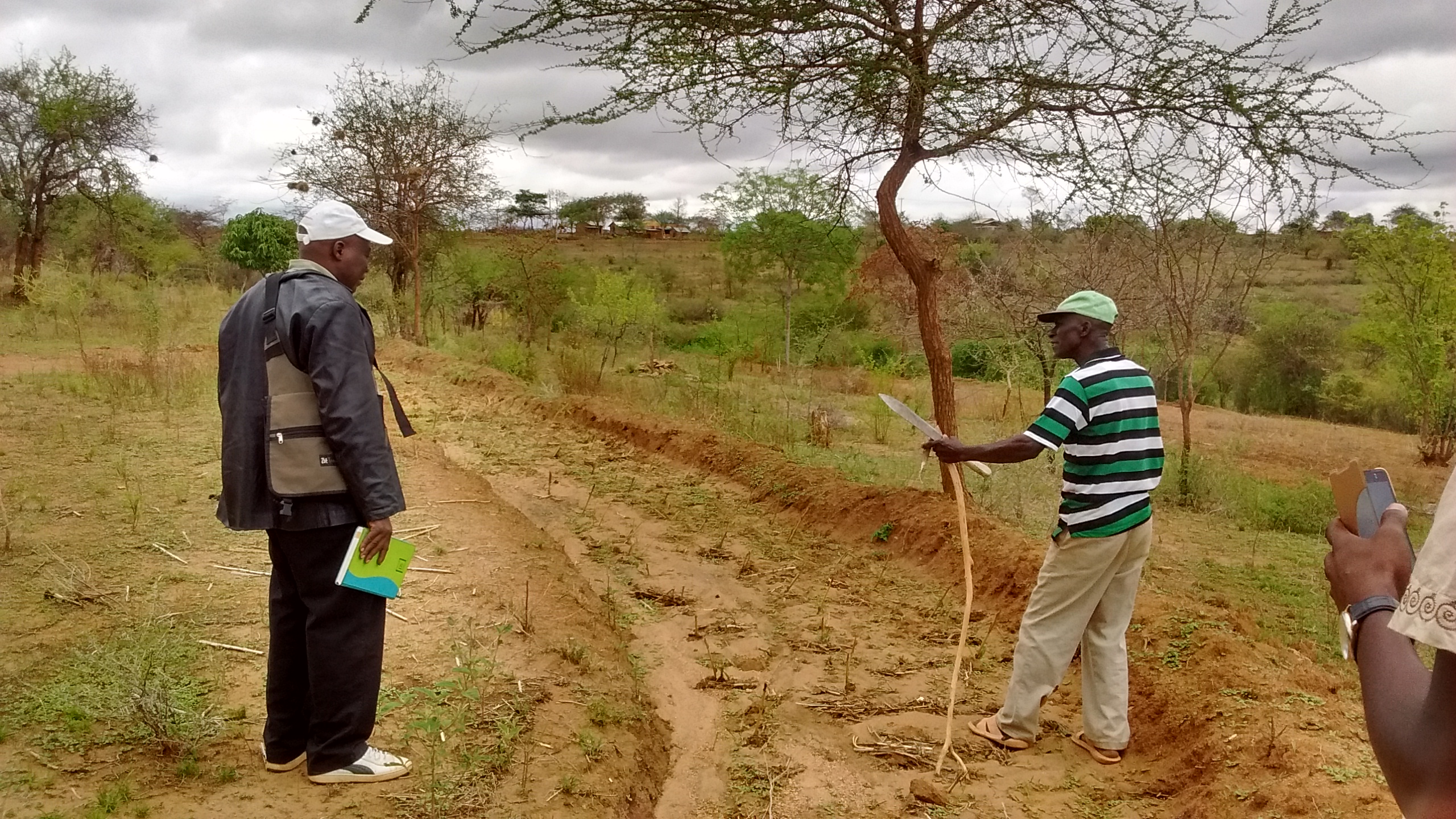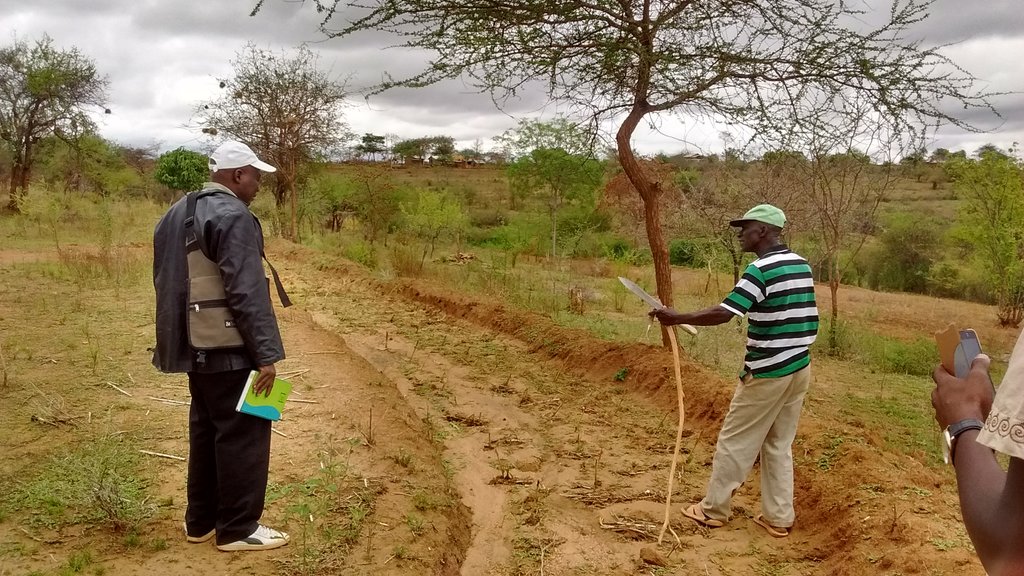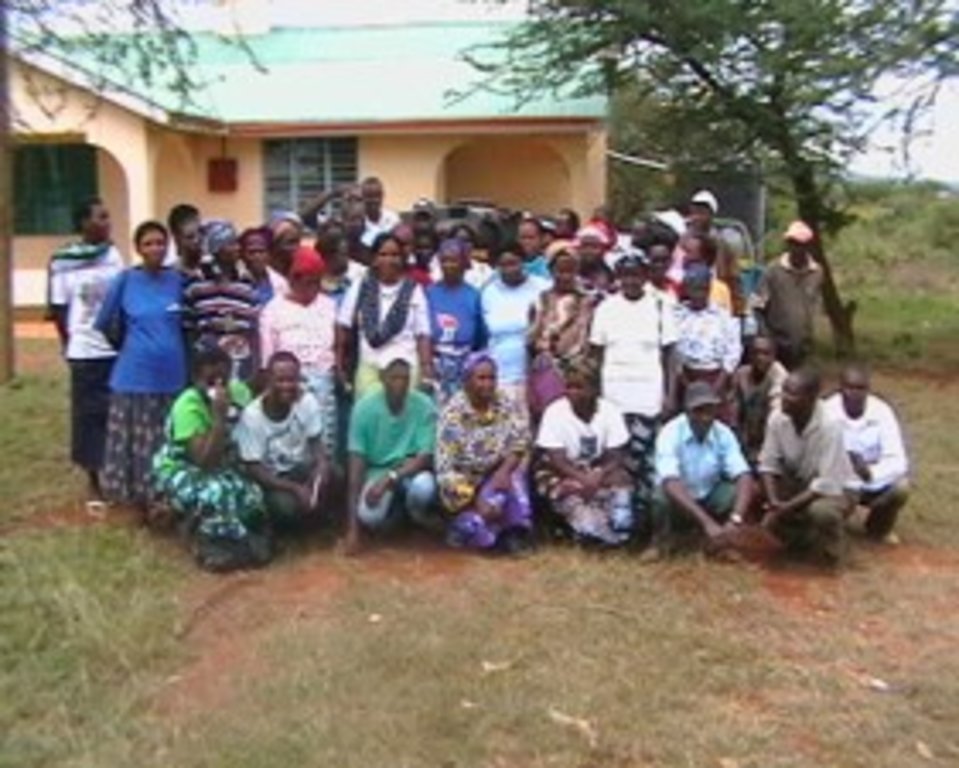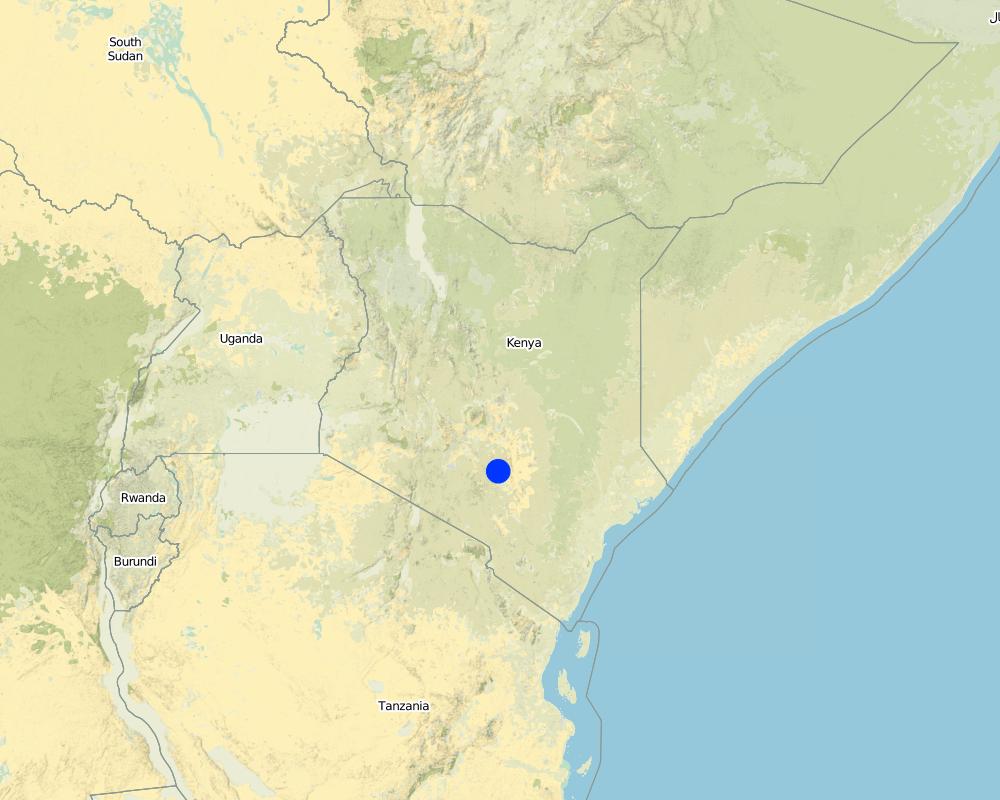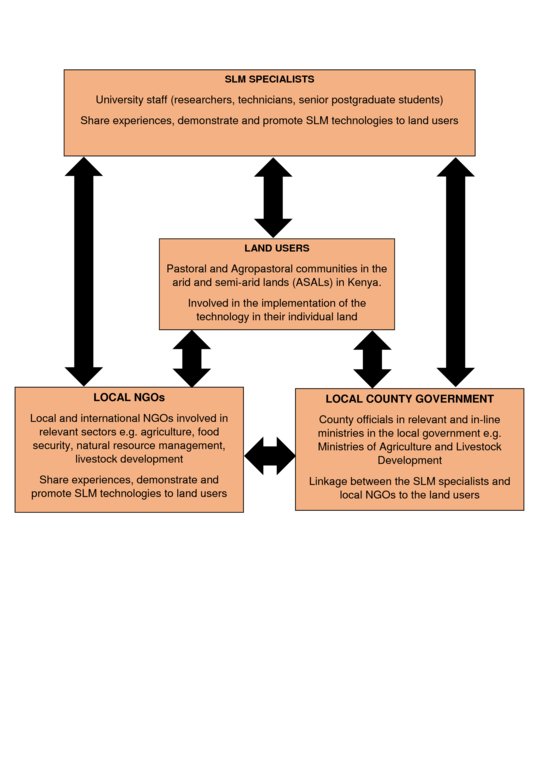In-situ pasture establishment demonstrations [เคนยา]
- ผู้สร้างสรรค์:
- การอัพเดท:
- ผู้รวบรวม: Kevin Mganga
- ผู้เรียบเรียง: –
- ผู้ตรวจสอบ: Rima Mekdaschi Studer
On-farm demos
approaches_3285 - เคนยา
- บทสรุปทั้งหมดในรูปแบบของ PDF
- บทสรุปทั้งหมดในรูปแบบของ PDF เพื่อพิมพ์
- บทสรุปทั้งหมดในรูปหน้าเว็บ
- บทสรุปทั้งหมด (ไม่มีการจัดเรียง)
- In-situ pasture establishment demonstrations: 26 มกราคม 2018 (inactive)
- On-farm pasture establishment demonstrations : 21 กุมภาพันธ์ 2018 (inactive)
- On-farm indigenous pasture establishment demonstrations : 20 เมษายน 2018 (inactive)
- On-farm indigenous pasture establishment demonstrations : 3 กันยายน 2018 (public)
ดูส่วนย่อย
ขยายทั้งหมด ย่อทั้งหมด1. ข้อมูลทั่วไป
1.2 รายละเอียดที่ติดต่อได้ของผู้รวบรวมและองค์กรที่เกี่ยวข้องในการประเมินและการจัดเตรียมทำเอกสารของแนวทาง
วิทยากรหลัก
ผู้เชี่ยวชาญ SLM:
ชื่อของโครงการซึ่งอำนวยความสะดวกในการทำเอกสารหรือการประเมินแนวทาง (ถ้าเกี่ยวข้อง)
Book project: Guidelines to Rangeland Management in Sub-Saharan Africa (Rangeland Management)ชื่อของโครงการซึ่งอำนวยความสะดวกในการทำเอกสารหรือการประเมินแนวทาง (ถ้าเกี่ยวข้อง)
Department of Range and Wildlife Sciences, South Eastern Kenya University (SEKU) - เคนยา1.3 เงื่อนไขที่เกี่ยวข้องกับการใช้ข้อมูลที่ได้บันทึกไว้ผ่านทาง WOCAT
วันที่เก็บรวบรวมข้อมูล (ภาคสนาม):
10/11/2017
ผู้รวบรวมและวิทยากรหลักยอมรับเงื่อนไขเกี่ยวกับการใช้ข้อมูลที่ถูกบันทึกผ่านทาง WOCAT:
ใช่
1.4 การอ้างอิงถึงแบบสอบถามเรื่องเทคโนโลยี SLM
2. คำอธิบายของแนวทาง SLM
2.1 การอธิบายแบบสั้น ๆ ของแนวทาง
In-situ pasture establishment demonstration programs and initiatives in the arid and semi-arid environments in Kenya. A more practical approach to enable the end-users appreciate the technology for easier adoption in their individual farms.
2.2 การอธิบายอย่างละเอียดของแนวทาง
การอธิบายอย่างละเอียดของแนวทาง:
The main characteristic and distinct feature is the interaction of different stakeholders (land users, NGOs, SLM specialists, local government officials and university researchers) in on-farm showcasing of sustainable land management technologies. Sustainable land management specialists, mostly researchers from the university with the help of local government and NGOs field officers demonstrate the entire process of grass reseeding technology from site selection, seedbed preparation, grass species selection, weeding, monitoring and evaluation (both plant and soil parameters). The main method used was on-farm demonstrations both at individual and pastoral and agropastoral groups sites (local land users sites) and a model demonstration site within the university premises (university site). The main stakeholders involved in the process are the SLM specialists, mainly researchers from the university (to share the knowledge, skills and technology), local government (county officials) (link the SLM specialists with the pastoral communities, share their experiences through on-farm demonstrations and explanations of similar technologies), local NGOs (to share the knowledge, past experiences and skills) and pastoral communities (the end users of the technologies, who also shared their indigenous technical knowledge related to natural resource management). The end-users, approximately 40 livestock keepers during the 5 visits and demonstrations, liked the approach because it was more practical (seeing is believing) i.e. on-farm, and can be easily replicated in individual lands under the same local conditions e.g. climate, soil type, grass species, methods of land preparation, land use system. After interacting with the SLM specialists from the universities during the visits and on-farm demonstrations, land-users have adopted the technology to ensure a continuous supply of pasture for their livestock.
2.3 รูปภาพของแนวทาง
ข้อสังเกตทั่วไปเกี่ยวกับรูปภาพ:
Stakeholders discussing and sharing their knowledge and skills
2.5 ประเทศ ภูมิภาค หรือสถานที่ตั้งที่ได้นำแนวทางไปใช้
ประเทศ:
เคนยา
ภูมิภาค/รัฐ/จังหวัด: :
Eastern Province
ข้อมูลเฉพาะเพิ่มเติมของสถานที่ตั้ง:
Kitui municipality, Kitui county
Map
×2.6 วันที่เริ่มต้นและสิ้นสุดของแนวทาง
ถ้าไม่รู้ปีที่แน่นอนให้ประมาณวันที่ที่ริเริ่มใช้แนวทางนี้ :
น้อยกว่า 10 ปี (เร็วๆนี้)
2.7 ประเภทของแนวทาง
- เป็นนวัตกรรมท้องถิ่นล่าสุด/ นวัตกรรมใหม่
2.8 เป้าหมายหรือวัตถุประสงค์หลักของแนวทาง
Demonstrate indigenous pasture establishment in-situ and encourage land users to practice reseeding as a means of 1) rehabilitating their degraded lands, 2) provide forage for their livestock and 3) income generation through sale of surplus animal products(e.g. milk), hay and seeds.
2.9 เงื่อนไขที่เอื้ออำนวยหรือเป็นอุปสรรคต่อการนำเทคโนโลยีภายใต้แนวทางนี้ไปปฏิบัติใช้
บรรทัดฐานและค่านิยมทางสังคม วัฒนธรรม ศาสนา
- เอื้ออำนวย
Land users are livestock keepers so technologies and approaches to improve livestock production are welcome.
- เป็นอุปสรรค
Gender based constraints where the male dominate on-farm training/demonstrations compared to female land users
การมีไว้ให้หรือการเข้าถึงแหล่งการเงินและบริการ
- เอื้ออำนวย
Facilitation from previous (Agricultural Innovation for Dryland Africa, AIDA) and on-going research project (Rainwater harvesting for Indigenous Pasture Production, ROFIP, in semi-arid Kitui County, Kenya). The current ROFIP project is under the Food and Business Applied Research Fund (ARF) funded by the he Netherlands Organisation for Scientific Research (NWO)
- เป็นอุปสรรค
Accessing money/financial resources from government/public institutions and organisation is long (much slower) due to e.g. bureaucracy and protocol, compared to private organisation (much faster access, less bureaucratic)
การจัดตั้งระดับองค์กร
- เอื้ออำนวย
University encourages extension service delivery to the local community and supports such initiatives to reach out to land users to share knowledge and expertise.
- เป็นอุปสรรค
Coordinating different stakeholders both in the private (NGOs) and public sector (university, local government), together with land users is often a challenge mainly due to the different nature of operations e.g. bureaucracy, protocol
การร่วมมือหรือการทำงานประสานกันของผู้ลงมือปฏิบัติ
- เอื้ออำนวย
Collaboration between university, local government and local land users
- เป็นอุปสรรค
Different stakeholders (e.g. land users, university, local government, NGOs) all have different key objectives to achieve within the general aim/objectives. This often hinders the coordination of actors and implementation of the approach.
กรอบแนวทางในการดำเนินการด้านกฎหมาย (การถือครองที่ดิน สิทธิในการใช้ที่ดินและน้ำ)
- เอื้ออำนวย
Land used in the approach and for demonstrating the reseeding technology are privately owned.
- เป็นอุปสรรค
Land is owned as private, communal and group. This determines the organisation and arrangement of the approach.
การกำกับดูแลที่ดิน (การตัดสินใจ การนำเอาไปปฏิบัติใช้ และการบังคับใช้)
- เอื้ออำนวย
ความรู้เกี่ยวกับ SLM การเข้าถึงการสนับสนุนด้านเทคนิค
- เอื้ออำนวย
SLM specialists have knowledge about the SLM technologies and various approaches.
ตลาด (จัดซื้อปัจจัยนำเข้า ขายผลิตภัณฑ์) และราคา
- เอื้ออำนวย
- เป็นอุปสรรค
Some of the inputs e.g. indigenous grass seeds, are not available in the formal seed market in Kenya. Reliance on the informal seed market often leads to the purchase and use of uncertified seeds with poor end results.
ปริมาณงานที่ทำได้ กำลังคนที่มีให้
- เอื้ออำนวย
Use of local casual labourers. This contributes to owning the project activities and easier implementation in their individual farms.
- เป็นอุปสรรค
Division of man-hours between the project demonstration sites and individual activities. This may often lead to delays in implementing project activities.
3. การมีส่วนร่วมและบทบาทของผู้มีส่วนได้ส่วนเสียที่เกี่ยวข้อง
3.1 ผู้มีส่วนได้ส่วนเสียที่เกี่ยวข้องในแนวทางนี้และบทบาท
- ผู้ใช้ที่ดินระดับท้องถิ่นหรือชุมชนระดับท้องถิ่น
local land users and livestock keepers
Share their indigenous technical knowledge; provide land for on-farm demonstrations
- ผู้เชี่ยวชาญ SLM หรือที่ปรึกษาการเกษตร
university researchers
Describe the technologies using practical on-farm demonstrations. Additionally, share and present scientific research findings to demonstrate the contribution of the use of the technology for increased indigenous pasture production i.e. evidence based
- ครู เด็กนักเรียน หรือนักศึกษา
university students
Practical demonstrations
- องค์กรพัฒนาเอกชน
Local NGO (Roads for Water)
Collaborate with university researchers to demonstrate to different land users and managers (e.g. researchers, pastoral and agropastoral communities) how other land management strategies e.g. rainwater harvesting using roads as a catchment can be incorporated in reseeding programs to enhance pasture establishment especially in dryland environments.
- รัฐบาลระดับท้องถิ่น
Extension agents and advisors in the county government
Link to the end-users, share past experiences and knowledge on SLM approaches
3.2 การเกี่ยวข้องของผู้ใช้ที่ดินระดับท้องถิ่นหรือชุมชนระดับท้องถิ่นในช่วงต่างๆของแนวทาง
| ความเกี่ยวข้องของผู้ใช้ที่ดินระดับท้องถิ่นหรือชุมชนระดับท้องถิ่น | ระบุผู้ที่มีส่วนเกี่ยวข้องและอธิบายกิจกรรม | |
|---|---|---|
| การริเริ่มหรือการจูงใจ | ปฏิสัมพันธ์ | Local land users involved in the site selection and involved in the plans of the project. Local land users share their indigenous technical knowledge (ITK) gained through man years of experience on aspects such as; which species are preferred by free grazing animals (i.e. ranking different species); which grass species perform better under different rainfall regimes, topography and soil types; which grass species are best suited for soil conservation and soil erosion control. |
| การวางแผน | ปฏิสัมพันธ์ | Local land users actively involved in deciding on scheduled land users visits and demonstrations. Local land users participate and contribute to the planning of e.g. sowing dates, methods of land preparation, grass species selection in relation to their individual taste and preference and intended use (fodder for livestock, soil conservation and combating degradation, large scale seed production). |
| การดำเนินการ | ปฏิสัมพันธ์ | Demonstration conducted on individual 'farms'/ pastures and local land users implement the technologies as 'model land users'. |
| การติดตามตรวจสอบหรือการประเมินผล | ปฏิสัมพันธ์ | Constant communication from through short message services (SMS) and telephone calls on progress and challenges as land users monitor changes e.g. seed germination, seedling establishment. Local land users report this to the SLM specialists e.g. researchers in the university and post-graduate students involved in the projects. |
| Research | ไม่ลงมือ | Research is mainly conducted by SLM specialists at university and students. Local government are also involved in doing research since some of the students recruited to be part of the project e.g PhD and MSc students are permanently employed by the local government. Local land users share their indigenous technical knowledge (ITK) through one-on-one informal discussions/sessions between them and the SLM specialists and students. |
3.3 แผนผังแสดงขั้นตอนการทำงาน (ถ้ามี)
คำอธิบาย:
Interaction between different stakeholders (SLM specialists, local government, local NGOs and land users) for in-situ pasture establishment demonstrations in arid and semi-arid environments in Kenya
ผู้เขียน:
Kevin Z. Mganga
3.4 การตัดสินใจเลือกใช้เทคโนโลยี SLM
ระบุผู้ที่ทำการตัดสินใจเลือกเทคโนโลยีมากกว่าหนึ่งวิธีไปปฏิบัติใช้:
- ผู้ลงมือปฏิบัติที่เกี่ยวข้องทั้งหมดในฐานะที่เป็นส่วนรวมของแนวทาง
ระบุว่าการตัดสินใจตั้งอยู่บนพื้นฐานของ:
- การประเมินความรู้ SLM ที่ได้ทำการบันทึกไว้เป็นอย่างดี (การใช้ข้อมูลในการตัดสินใจ)
- สิ่งที่ค้นพบจากงานวิจัย
- ประสบการณ์และความคิดเห็นส่วนตัว (ไม่ได้ลงบันทึกไว้)
4. การสนับสนุนด้านเทคนิค การสร้างขีดความสามารถ และการจัดการด้านความรู้
4.1 การสร้างขีดความสามารถ / การอบรม
ได้มีการจัดอบรมให้แก่ผู้ใช้ที่ดินหรือผู้มีส่วนได้ส่วนเสียคนอื่น ๆ หรือไม่:
ใช่
ให้ระบุว่าใครเป็นผู้ได้รับการอบรม:
- ผู้ใช้ที่ดิน
- เจ้าหน้าที่ภาคสนาม / ที่ปรึกษา
ถ้าเกี่ยวข้อง ให้ระบุ เพศ อายุ สถานภาพ ชาติพันธุ์ เป็นต้น:
The land users and field staff/advisers were drawn from both genders (male and female). University undergraduate students (both male and female students, between the ages of 20-24 years) were also involved in the training during on-farm practical sessions.
รูปแบบการอบรม:
- ใช้พื้นที่ทำการสาธิต
หัวข้อที่พูด:
site selection, seedbed preparation, choice of grass species, monitoring and evaluation (plant and soil attributes), maintenance and further management
4.2 การบริการให้คำแนะนำ
ผู้ใช้ที่ดินมีการเข้าถึงการรับบริการให้คำปรึกษาหรือไม่:
ใช่
ระบุว่ามีบริการให้คำปรึกษาหรือไม่:
- ไปเยี่ยมชมสถานที่
การอธิบาย/แสดงความคิดเห็น:
Advisory services on-farm during visits
4.3 การเสริมความแข็งแกร่งให้กับสถาบัน (การพัฒนาองค์กร)
สถาบันได้รับการจัดตั้งขึ้นมาหรือเสริมความแข็งแกร่งโดยแนวทางนี้หรือไม่:
- ใช่ ปานกลาง
ระบุระดับของสถาบันที่ได้รับการเสริมความแข็งแกร่งหรือจัดตั้งขึ้นมา:
- ท้องถิ่น
- ภูมิภาค
- ประเทศ
อธิบายถึงสถาบัน บทบาทและความรับผิดชอบ สมาชิก เป็นต้น:
University (South Eastern Kenya University, SEKU) - extension and outreach and research and academic exchange programs with other research institutions e.g. Kenya Agricultural and Livestock Research Organization (KALRO), International Crops Research Institute for the Semi-Arid Tropics (ICRISAT), Kenya Seed Company, and other universities e.g. University of Nairobi (UoN)
ระบุประเภทของการให้ความช่วยเหลือสนับสนุน:
- ด้านการเงิน
- การสร้างขีดความสามารถ / การอบรม
ให้รายละเอียดเพิ่มเติม :
Financial support from within university research funds and the National Research Fund (NRF), Kenya, through the Ministry of Education, Science and Technology. Capacity building through postgraduate training involving researchers from SEKU, KALRO, ICRISAT and UoN
4.4 การติดตามตรวจสอบและประเมินผล
การติดตามตรวจสอบและประเมินผลเป็นส่วนหนึ่งของแนวทางหรือไม่:
ใช่
ความคิดเห็น:
Adoption and uptake of the technologies among land users
ถ้าตอบว่าใช่ แสดงว่าการจัดเตรียมเอกสารนี้มุ่งหวังที่จะเอาไปใช้สำหรับการติดตามตรวจสอบและประเมินผลใช่หรือไม่:
ใช่
ความคิดเห็น:
The approach demonstrates sustainable land management technologies e.g. grass reseeding, on farm. This is aimed at increasing adoption and spread of the technology by other land users.
4.5 การวิจัย
การวิจัยเป็นส่วนหนึ่งของแนวทางหรือไม่:
ใช่
ระบุหัวข้อเรื่อง:
- นิเวศวิทยา
- เทคโนโลยี
ให้ข้อมูลเพิ่มเติมและให้ระบุผู้ทำการวิจัย:
Part of a SLM specialist i.e. researcher at the university, research project
5. การสนับสนุนด้านการเงินและวัสดุอุปกรณ์
5.1 ระบุงบประมาณประจำปีสำหรับแนวทาง SLM นี้
ถ้าหากว่างบประมาณประจำปีไม่เป็นที่ทราบแน่นอน ให้ระบุช่วงลงไป:
- 2,000-10,000
แสดงความคิดเห็น (แหล่งของการระดมทุน ผู้บริจาคคนสำคัญ):
Food and Business Applied Research Fund (ARF) funded by the The Netherlands Organisation for Scientific Research (NWO), Netherlands
5.2 การสนับสนุนด้านการเงิน / วัสดุอุปกรณ์ให้แก่ผู้ใช้ที่ดิน
ผู้ใช้ที่ดินได้รับการสนับสนุนด้านการเงิน / วัสดุอุปกรณ์ไปปฏิบัติใช้เทคโนโลยีหรือไม่:
ใช่
ถ้าใช่ ให้ระบุประเภทของการสนับสนุน เงื่อนไขและผู้จัดหามาให้:
Land and seed bed preparation: hiring of casual labour and rent of machinery/equipment (ox-plough/tractor)
5.3 เงินสนับสนุนสำหรับปัจจัยนำเข้า (รวมถึงแรงงาน)
- แรงงาน
| เห็นด้วยระดับไหน | ระบุเงินสนับสนุน |
|---|---|
| ได้รับการช่วยเหลือทางการเงินบางส่วน | In cash subsidy mainly for land/site preparation e.g. creating of micro-catchments using ox-driven ploughs, digging trenches as structures for rainwater harvesting. |
- อุปกรณ์
| ระบุปัจจัยนำเข้าที่ได้รับการสนับสนุน | เห็นด้วยระดับไหน | ระบุเงินสนับสนุน |
|---|---|---|
| เครื่องจักร | ได้รับการช่วยเหลือทางการเงินแบบเต็ม | Ox-driven ploughs for site preparation. Occasionally tractors |
| เครื่องมือ | ได้รับการช่วยเหลือทางการเงินแบบเต็ม | Hand held hoes for bush clearing and site preparation |
- การเกษตร
| ระบุปัจจัยนำเข้าที่ได้รับการสนับสนุน | เห็นด้วยระดับไหน | ระบุเงินสนับสนุน |
|---|---|---|
| เมล็ด | ได้รับการช่วยเหลือทางการเงินแบบเต็ม | Indigenous grass seeds used in the technology and approach are provided for by the project. However, seed for subsequent sowing is expected to be harvested from the established pasture sites |
ถ้าแรงงานโดยผู้ใช้ที่ดินเป็นปัจจัยนำเข้าที่มีอยู่มากมาย ระบุด้วยว่าเนื่องจาก:
- สมัครใจ
ความคิดเห็น:
This is mainly for maintaining, monitoring and evaluation of the on-farm sites e.g. aspects of maintaining the fence to keep of free-ranging livestock from damaging the established pastures and assisting other hired labourers e.g. in seeding.
5.4 เครดิต
มีการจัดหาเครดิตมาให้ภายใต้แนวทาง SLM หรือไม่:
ไม่ใช่
5.5 แรงจูงใจหรือเครื่องมืออื่น ๆ
แรงจูงใจหรือเครื่องมืออื่น ๆ ได้ถูกนำไปใช้ส่งเสริมการใช้เทคโนโลยี SLM หรือไม่:
ไม่ใช่
6. การวิเคราะห์ผลกระทบและการสรุป
6.1 ผลกระทบของแนวทาง
ทำให้ผู้ใช้ที่ดินระดับท้องถิ่นมีอำนาจขึ้น ปรับปรุงการเข้าร่วมของผู้มีส่วนได้ส่วนเสียให้ดีขึ้นหรือไม่:
- ไม่ใช่
- ใช่ เล็กน้อย
- ใช่ ปานกลาง
- ใช่ อย่างมาก
They owned and embraced the initiative since it involved them from the onset
ช่วยในการตัดสินใจโดยดูจากหลักฐาน ได้หรือไม่:
- ไม่ใช่
- ใช่ เล็กน้อย
- ใช่ ปานกลาง
- ใช่ อย่างมาก
On-farm sites are used for both demonstrations and experimental plots for research. This is mainly conducted by SLM specialists from the university and postgraduate students in close collaboration with land users (e.g. farmers) aimed at comparing different treatments for the technologies.
ช่วยให้ผู้ใช้ที่ดินนำเอาเทคโนโลยี SLMไปใช้และบำรุงรักษาสภาพไว้ได้หรือไม่:
- ไม่ใช่
- ใช่ เล็กน้อย
- ใช่ ปานกลาง
- ใช่ อย่างมาก
Practical on-farm demonstrations in their individual farms
ปรับปรุงความร่วมมือกันและการดำเนิน งานของ SLM ได้อย่างมีประสิทธิผลหรือไม่:
- ไม่ใช่
- ใช่ เล็กน้อย
- ใช่ ปานกลาง
- ใช่ อย่างมาก
Communication through SMS and phone calls, exchange of photos/videos of demonstrations through WhatsApp groups and emails
ระดมกำลังหรือปรับปรุงการเข้าถึงแหล่ง เงินทุนสำหรับการดำเนินการ SLM หรือไม่:
- ไม่ใช่
- ใช่ เล็กน้อย
- ใช่ ปานกลาง
- ใช่ อย่างมาก
Joint research grants and funds through collaborative work among stakeholders mostly between local NGOs and universities
ปรับปรุงความรู้และความสามารถของผู้ใช้ที่ดินในการดำเนินการ SLM หรือไม่:
- ไม่ใช่
- ใช่ เล็กน้อย
- ใช่ ปานกลาง
- ใช่ อย่างมาก
Through practical and hands-on on-farm demonstrations by SLM specialists
ปรับปรุงความรู้และความสามารถของผู้มีส่วนได้ส่วนเสียคนอื่น ๆ ให้ดีขึ้นหรือไม่:
- ไม่ใช่
- ใช่ เล็กน้อย
- ใช่ ปานกลาง
- ใช่ อย่างมาก
Local government and NGOs appreciating the technologies and serve as ambassadors of the same
ทำให้ผู้ใช้ที่ดินระดับท้องถิ่นมีอำนาจขึ้น ปรับปรุงการเข้าร่วมของผู้มีส่วนได้ส่วนเสียให้ดีขึ้นหรือไม่:
- ไม่ใช่
- ใช่ เล็กน้อย
- ใช่ ปานกลาง
- ใช่ อย่างมาก
Collaboration between universities, local government, local NGOs and land users strenghtened
ช่วยบรรเทาความขัดแย้งหรือไม่:
- ไม่ใช่
- ใช่ เล็กน้อย
- ใช่ ปานกลาง
- ใช่ อย่างมาก
ทำให้กลุ่มด้อยโอกาสมีอำนาจทางสังคมและเศรษฐกิจหรือไม่:
- ไม่ใช่
- ใช่ เล็กน้อย
- ใช่ ปานกลาง
- ใช่ อย่างมาก
ปรับปรุงความทัดเทียมกันด้านเพศและให้อำนาจแก่ผู้หญิงและเด็กผู้หญิงหรือไม่:
- ไม่ใช่
- ใช่ เล็กน้อย
- ใช่ ปานกลาง
- ใช่ อย่างมาก
Female land users involved
ส่งเสริมให้เยาวชนหรือบุตรหลานของผู้ใช้ที่ดินให้เข้าร่วมใน SLM:
- ไม่ใช่
- ใช่ เล็กน้อย
- ใช่ ปานกลาง
- ใช่ อย่างมาก
Young farmers involved. Also students in universities as part of practicals.
นำไปสู่ความมั่นคงด้านอาหารหรือปรับปรุงโภชนาการให้ดีขึ้น:
- ไม่ใช่
- ใช่ เล็กน้อย
- ใช่ ปานกลาง
- ใช่ อย่างมาก
Improved pasture production for livestock, healthy animals
ปรับปรุงการเข้าถึงตลาดหรือไม่:
- ไม่ใช่
- ใช่ เล็กน้อย
- ใช่ ปานกลาง
- ใช่ อย่างมาก
Market for sale of grass seeds
ปรับปรุงความสามารถของผู้ใช้ที่ดินในการปรับตัวให้เข้ากับการเปลี่ยนแปลงของสภาพภูมิอากาศหรือสภาพที่รุนแรงและภัยพิบัติหรือไม่:
- ไม่ใช่
- ใช่ เล็กน้อย
- ใช่ ปานกลาง
- ใช่ อย่างมาก
Combining the use of indigenous drought tolerant grass species and water harvesting
นำไปสู่โอกาสในการจ้างงาน รายได้หรือไม่:
- ไม่ใช่
- ใช่ เล็กน้อย
- ใช่ ปานกลาง
- ใช่ อย่างมาก
Through sale of grass seeds and hay, surplus animal products (mostly milk) in seasons of plenty.
6.2 แรงจูงใจหลักของผู้ใช้ที่ดินเพื่อที่จะนำ SLM ไปปฏิบัติใช้
- การผลิตที่เพิ่มขึ้น
Increased pasture yields (improved livestock production)
- กำไร (ความสามารถ) อัตราส่วนค่าใช้จ่ายต่อผลประโยชน์ที่เพิ่มขึ้น
Sale of grass seeds and hay and surplus animal products e.g. milk and healthy animals at a good market price
- การเสื่อมของที่ดินลดลง
Established pastureland reduces soil erosion and contributes to enhanced soil moisture and C-sequestration (soil ecosystem services).
- จิตสำนึกด้านสิ่งแวดล้อม
Environmental conservation
6.3 ความยั่งยืนของกิจกรรมของแนวทาง
ผู้ใช้ที่ดินสามารถทำให้สิ่งต่างๆ ที่ได้ปฏิบัติใช้โดยแนวทางนี้ยั่งยืนได้หรือไม่ (โดยไม่มีการสนับสนุนจากภายนอก):
- ใช่
ถ้าตอบว่าใช่ ให้อธิบายว่าอย่างไร :
Approach is practical and involves the use of already existing knowledge and skills e.g. use of ox-plough for site preparation (creating micro-catchments) is not foreign; local land users have interacted with the indigenous grasses
6.4 จุดแข็งและข้อได้เปรียบของแนวทาง
| จุดแข็ง / ข้อได้เปรียบของแนวทางในทัศนคติของผู้ใช้ที่ดิน |
|---|
| Ease to understand and appreciate because of its practical nature |
| Approach allows a close interaction and exchange between the different stakeholders (land users, NGOs, local government officials, SLM specialists, universities) i.e. provides a link between science-practice link, learning by doing. |
| จุดแข็ง / ข้อได้เปรียบของแนวทางในทัศนคติของผู้รวบรวมหรือวิทยากรหลัก |
|---|
| On-farm and practical approach for easy adoption by other land users |
| Takes advantage of group dynamics where different stakeholders share and provide immediate feedback and seek clarification throughout the process thus enriching the discussions |
6.5 จุดอ่อน / ข้อเสียเปรียบของแนวทางและวิธีในการแก้ไข
| จุดอ่อน / ข้อเสียเปรียบในทัศนคติของผู้ใช้ที่ดิน | สามารถแก้ไขปัญหาได้อย่างไร |
|---|---|
| Source of conflict between land user where the on-farm demonstration has been conducted and other neighboring land users e.g. diverting run-off in the upland thus reducing the volume of rainwater reaching farms located down-slope. | Continuous capacity building, knowledge sharing and sensitization |
| Choice of on-farm demonstration site at an individual land owner can lead to aggravation among other land users | Use of communal or group owned land for on-farm demonstrations |
| Allocation of time to attend the on-farm demonstrations. The approach is often conducted before the onset of the rains, when the land-users are busy preparing their own farms for sowing. This might lead to low turn-outs during demonstrations. | In consultation with the land users, set the date(s) when majority of the land users are available. |
| จุดอ่อน / ข้อเสียเปรียบในทัศนคติของผู้รวบรวมหรือวิทยากรหลัก | สามารถแก้ไขปัญหาได้อย่างไร |
|---|---|
| Language barrier (SLM specialists and land users) | Involving a local land user/personnel to bridge the gap |
7. การอ้างอิงและการเชื่อมต่อ
7.1 วิธีการหรือแหล่งข้อมูล
- ไปเยี่ยมชมภาคสนาม การสำรวจพื้นที่ภาคสนาม
20
- การสัมภาษณ์กับผู้ใช้ที่ดิน
50
7.2 การอ้างอิงถึงสิ่งตีพิมพ์
ชื่อเรื่อง ผู้เขียน ปี ISBN:
KZ Mganga, NKR Musimba, DM Nyariki. 2015. Competition indices of three perennial grasses used to rehabilitate degraded semi-arid rangelands in Kenya. The Rangelands Journal 37: 489-495
ช่องทางในการสืบค้น และราคา:
The Rangeland Journal, USD 25
ชื่อเรื่อง ผู้เขียน ปี ISBN:
KZ Mganga, NKR Musimba, DM Nyariki. 2015. Combining sustainable land management technologies to combat land degradation and improve rural livelihoods in semi-arid lands in Kenya. Environmental Management 56: 1538-1548
ช่องทางในการสืบค้น และราคา:
Environmental Management, USD 38
ชื่อเรื่อง ผู้เขียน ปี ISBN:
KZ Mganga, NKR Musimba, MM Nyangito, DM Nyariki, AW Mwang’ombe. 2015. The choice of grass species to combat desertification in semi-arid Kenyan rangelands is greatly influenced by their forage value for livestock. Grass and Forage Science 70: 161-167.
ช่องทางในการสืบค้น และราคา:
Grass and Forage Science, USD 38
7.3 เชื่อมโยงกับข้อมูลที่มีอยู่บนออนไลน์
ชื่อเรื่องหรือคำอธิบาย:
Competition indices of three perennial grasses used to rehabilitate degraded semi-arid rangelands in Kenya
URL:
http://www.publish.csiro.au/rj/RJ15023
ชื่อเรื่องหรือคำอธิบาย:
Combining sustainable land management technologies to combat land degradation and improve rural livelihoods in semi-arid lands in Kenya
URL:
https://link.springer.com/article/10.1007/s00267-015-0579-9
ชื่อเรื่องหรือคำอธิบาย:
The choice of grass species to combat desertication in semi-arid Kenyan rangelands is greatly inuenced by their forage value for livestock
URL:
http://onlinelibrary.wiley.com/doi/10.1111/gfs.12089/abstract
ลิงก์และโมดูล
ขยายทั้งหมด ย่อทั้งหมดลิงก์
ไม่มีลิงก์
โมดูล
ไม่มีโมดูล


